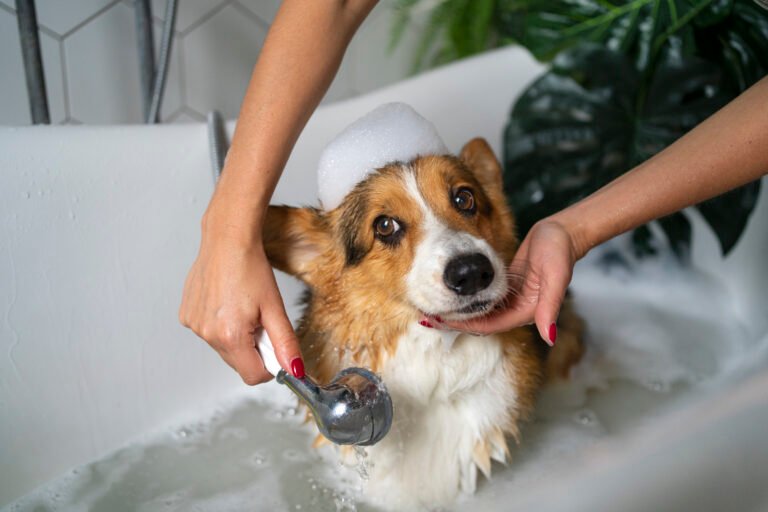Natural Remedies for Pet Anxiety and Stress
Pet anxiety and stress can have a significant impact on the well-being and health of our furry friends. It is important for pet owners to understand the causes and signs of anxiety in pets, as well as the potential consequences on their overall health. Fortunately, there are natural remedies for pet anxiety and stress that can help alleviate pet anxiety and create a calm environment for them. In this article, we will explore various strategies, including herbal supplements, aromatherapy, behavioral techniques, and physical and mental exercise. By implementing these methods, pet owners can provide their beloved companions with the care and support they need to overcome anxiety and stress.
Key Takeaways
- Understanding the causes and signs of pet anxiety is crucial for providing appropriate care.
- Creating a calm environment for your pet involves designing a safe and comfortable space, using soothing scents and music, and implementing a consistent routine.
- Natural remedies for pet anxiety include herbal supplements for relaxation, aromatherapy for calming effects, and massage and acupressure techniques.
- Behavioral techniques such as positive reinforcement training, desensitization, and interactive play can help reduce pet anxiety.
- Promoting physical and mental exercise through regular exercise, puzzle toys, and environmental enrichment is beneficial for managing pet anxiety.
Understanding Pet Anxiety and Stress

Causes of Pet Anxiety and Stress
Pet anxiety and stress can be caused by a variety of factors, ranging from separation anxiety to noise phobias or changes in their environment. Recognition of these triggers is the first step towards helping your pet. It’s important to create a safe and secure space for your dog to retreat to when feeling overwhelmed. This could be a quiet corner of your home with a comfy bed or crate that they can associate with feelings of security and calm. Regular physical activity is also essential for your dog’s mental wellbeing. Exercise helps to burn off excess energy that might otherwise contribute to their anxiety.
Recognizing the Signs of Pet Anxiety and Stress
This can range from separation anxiety to noise phobias or simply changes in their environment. Recognition of these triggers is the first step towards helping your pet.
Create a Safe Space
Ensuring your dog has a safe, secure place to retreat to when feeling overwhelmed can make a world of difference. This might be a quiet corner of your home with a comfy bed or crate that they can associate with feelings of security and calm.
Exercise: A Natural Stress Reliever
Regular physical activity is not just good for your dog’s physical health but also for mental wellbeing. Exercise helps to: Burn off excess energy that might otherwise feed into
The Impact of Anxiety and Stress on Pets’ Health
Anxiety and stress can have a significant impact on your pet’s health. These conditions can range from separation anxiety to noise phobias or simply changes in their environment. Recognition of these triggers is the first step towards helping your pet.
Creating a Safe Space: Ensuring your dog has a safe, secure place to retreat to when feeling overwhelmed can make a world of difference. This might be a quiet corner of your home with a comfy bed or crate that they can associate with feelings of security and calm.
Exercise: A Natural Stress Reliever: Regular physical activity is not just good for your dog’s physical health but also for mental wellbeing. Exercise helps to burn off excess energy that might otherwise feed into their anxiety and stress.
Table:
Here is a table showcasing the different health and supplement categories that can support your pet’s well-being:
| Category | Examples of Support |
|---|---|
| Brain & Cognitive | Support for brain function |
| Digestive | Support for digestive health |
| Critical Care & Recovery | Support for recovery |
| Senior Support | Support for senior pets |
| Skin & Coat | Support for skin and coat health |
| Urinary Tract | Support for urinary tract health |
Tip:
Remember to consult with your veterinarian before introducing any new supplements or treatments for your pet’s anxiety and stress.
Creating a Calm Environment for Your Pet

Designing a Safe and Comfortable Space
When creating a safe and comfortable space for your pet, it’s important to consider their specific needs and preferences. Design the space in a way that allows your pet to feel secure and relaxed. Provide a cozy bed or blanket where they can rest and sleep comfortably. Bowls for food and water should be easily accessible and placed in a quiet area. Additionally, consider using cleaning solutions that are safe for pets to ensure a hygienic environment.
To create a calming atmosphere, you can incorporate soothing scents and music. Certain scents, such as lavender or chamomile, have been known to have a calming effect on pets. Play soft, gentle music in the background to help create a peaceful ambiance. Consult with a veterinarian or pet behaviorist for recommendations on specific scents and music that may be beneficial for your pet.
Establishing a consistent routine is also important for reducing anxiety and stress. Pets thrive on predictability, so try to feed them and take them for walks at the same time each day. This helps create a sense of stability and security for your pet.
Using Soothing Scents and Music
When creating a calm environment for your pet, using soothing scents and music can be highly effective. Certain scents, such as lavender and chamomile, have calming properties that can help reduce anxiety in pets. You can use essential oils or scented sprays to create a relaxing atmosphere in your pet’s space. Additionally, playing soft and gentle music can have a soothing effect on your pet’s nervous system. Classical music or instrumental tunes are often recommended for their calming effects. By incorporating these scents and music into your pet’s environment, you can help create a sense of tranquility and promote relaxation.
Implementing a Consistent Routine
Establishing a consistent routine is essential for reducing pet anxiety and stress. Dogs, in particular, thrive on predictability and structure. By providing a daily routine that includes regular feeding times, exercise, and play, you can create a sense of stability and security for your furry friend. Additionally, incorporating training sessions into your pet’s routine can help stimulate their mind and provide a sense of accomplishment. Consistency is key when implementing a routine, so be sure to stick to the same schedule every day. This will help your pet feel more at ease and reduce their anxiety levels.
Natural Remedies for Pet Anxiety and Stress

Herbal Supplements for Relaxation
When it comes to helping your pet relax and reduce anxiety, herbal supplements can be a great option. Hemp and CBD oil for cats is one popular choice that has been shown to have calming effects. Other herbal supplements that can promote relaxation include:
- Chamomile: Known for its calming properties and its ability to support the immune and nervous systems.
- Passion Flower: An effective sedative that helps increase the brain’s gamma-aminobutyric acid (GABA) levels, leading to a feeling of relaxation.
- Lemon Balm: Used for nervous disorders and anxiety, lemon balm also has the added benefit of lowering blood pressure.
- Valerian: This herb helps with heart palpitations, spasms, pain relief, and regulating the nervous system. It can also improve sleep quality.
- Hops: Traditionally used for tension, anxiety, and stress relief in cats.
These herbal supplements can be a natural and non-addictive way to help your pet find calm and relaxation. Always consult with your veterinarian to determine the appropriate dosage for your pet’s weight and needs.
Aromatherapy for Calming Effects
Aromatherapy is a natural and effective way to help calm your pet’s anxiety and stress. Certain essential oils have been found to have a soothing effect on pets, promoting relaxation and a sense of calm. Review the following essential oils that are commonly used in aromatherapy for pets:
- Chamomile: Known for its calming properties, chamomile helps relax the nervous system and boost the immune system.
- Passion Flower: This non-addictive sedative increases gamma-aminobutyric acid (GABA) in the brain, inducing a feeling of relaxation.
- Lemon Balm: Used for nervous disorders and anxiety, lemon balm also helps lower blood pressure.
- Valerian: With its ability to stop heart palpitations, relax spasms, and regulate the nervous system, valerian is a powerful herb for reducing anxiety.
- Hops: Traditionally used for mood disturbances, hops provide tension and stress relief in cats.
When using essential oils for aromatherapy, it’s important to consult with your veterinarian to ensure the safety and appropriate dosage for your pet. Some essential oils can be toxic to pets, so it’s crucial to use them under professional guidance. Additionally, consider using products specifically formulated for pets, such as calming chews or treats, that contain natural ingredients known for their calming effects. These products can be a great addition to your pet’s anxiety management routine.
Massage and Acupressure Techniques
Just as humans benefit from massage therapy to reduce stress, dogs can too. Gentle massage can help relax tense muscles and lower cortisol levels – the stress hormone – in dogs. Learn basic dog massage techniques or consult with a professional to provide your pet with this soothing therapy. Training and Desensitization Anxiety triggered by certain stimuli can often be mitigated through gradual desensitization and counterconditioning. This technique involves gently exposing your dog to the source of their anxiety in controlled amounts and creating positive associations.
Behavioral Techniques to Reduce Pet Anxiety

Positive Reinforcement Training
Positive reinforcement training is a highly effective method for reducing pet anxiety and promoting positive behavior. By rewarding your pet for desired actions and behaviors, you can reinforce their confidence and create a strong bond of trust. Consistency is key when implementing this training technique, as it helps your pet understand what is expected of them. Use treats or praise as rewards to motivate your pet and make the training experience enjoyable. Here are some tips for successful positive reinforcement training:
- Break down commands into small, manageable steps to avoid overwhelming your pet.
- Use clear and concise verbal cues to communicate your expectations.
- Be patient and give your pet time to understand and respond to the training.
- Practice training sessions in a quiet and distraction-free environment.
Remember, positive reinforcement training is a gentle and effective way to address pet anxiety and build a strong bond with your furry friend.
Desensitization and Counterconditioning
Anxiety triggered by certain stimuli can often be mitigated through gradual desensitization and counterconditioning. This technique involves gently exposing your dog to the source of their anxiety in controlled amounts and creating positive associations. Additional Tips for Reducing Canine Anxiety:
- Use calming background noise, such as soft music or a white noise machine, to help mask anxiety-inducing sounds.
- Introduce mind-stimulating toys to help keep your dog mentally engaged and distracted from stressors.
- Ensure your dog has plenty of social interactions, as appropriate, to build confidence and alleviate anxiety.
Engaging in Interactive Play
Engaging in interactive play with your pet is a great way to bond and provide mental stimulation. Playing helps to reduce anxiety and stress by promoting the release of endorphins, which are natural mood boosters. It also provides an outlet for pent-up energy and frustration, helping to prevent destructive behaviors. Interactive play can include activities such as fetch, tug-of-war, or hide-and-seek. Rotate different toys to keep things exciting and engaging for your pet. Remember to observe your pet’s body language and limit play sessions if they show signs of fatigue or overstimulation.
Promoting Physical and Mental Exercise

Regular Exercise for Stress Relief
Regular physical activity is not just good for your dog’s physical health but also for mental wellbeing. Exercise helps to: Burn off excess energy that might otherwise feed into anxious behaviors. Release endorphins which naturally promote a sense of peace. Establish a routine, which can help reduce anxiety in dogs that enjoy predictability. Choose the exercise that best suits your dog’s breed, age, and health status. For breeds that are prone to arthritis, or dogs that already have arthritis, make certain they are receiving joint care supplements so exercise isn’t painful.
Mental Stimulation through Puzzle Toys
Mental stimulation is an essential aspect of keeping your pet happy and healthy. Puzzle toys are a great way to provide mental exercise for your dog. These toys challenge your dog’s problem-solving skills and keep them engaged for hours. They are designed to hide treats or kibble inside, encouraging your dog to use their nose and paws to figure out how to access the reward. Exercise as a stress reliever for dogs is crucial, and puzzle toys offer a fun and interactive way to achieve this. By engaging in puzzle toy play, your dog can release pent-up energy and reduce anxiety and stress levels. It also helps prevent boredom and destructive behaviors that can arise from a lack of mental stimulation.
Enriching Your Pet’s Environment
Creating a stimulating and enriching environment for your pet is crucial for their overall well-being and mental health. Here are some tips to help you enrich your pet’s environment:
- Provide plenty of interactive toys and puzzles to keep your pet mentally stimulated and engaged. These toys can help alleviate boredom and provide a healthy outlet for their natural instincts.
- Set up different areas in your home where your pet can explore and play. This can include designated play areas, scratching posts for cats, and climbing structures for small animals.
- Incorporate sensory experiences into your pet’s environment. Use different textures, scents, and sounds to create a sensory-rich environment that can help calm and relax your pet.
- Create a safe outdoor space for your pet to explore. If you have a backyard, consider setting up a secure and enclosed area where your pet can safely enjoy the outdoors.
Remember, each pet is unique, so it’s important to observe and understand their preferences and needs. By enriching their environment, you can help reduce stress and anxiety, and promote a happy and healthy life for your beloved pet.
Seeking Professional Help for Pet Anxiety

Consulting with a Veterinarian
When it comes to addressing your pet’s anxiety, consulting with a veterinarian is crucial. They have the expertise and knowledge to assess your pet’s specific needs and recommend the most appropriate solutions. A veterinarian can help determine the underlying causes of your pet’s anxiety and develop a tailored anxiety reduction plan. They may suggest a combination of natural remedies, behavioral techniques, and, if necessary, medication options. By working closely with a veterinarian, you can ensure that you are taking the right steps to help your pet feel calmer and more at ease.
Working with a Certified Animal Behaviorist
When dealing with pet anxiety, it can be beneficial to work with a certified animal behaviorist. These professionals have extensive knowledge and experience in understanding and addressing pet behavior issues. They can provide valuable insights and guidance on how to help your pet overcome anxiety and stress.
Here are some ways a certified animal behaviorist can assist you:
- Conduct a thorough assessment of your pet’s behavior and anxiety triggers.
- Develop a personalized behavior modification plan tailored to your pet’s specific needs.
- Teach you effective techniques and strategies to manage and reduce your pet’s anxiety.
- Provide ongoing support and guidance throughout the behavior modification process.
Remember, every pet is unique, and what works for one may not work for another. Working with a certified animal behaviorist can greatly increase the chances of finding effective solutions for your pet’s anxiety and stress. Don’t hesitate to reach out to a professional for help and support.
Exploring Medication Options
When exploring medication options for your dog, it’s important to choose a product that is safe and approved by veterinarians. Read the label carefully and follow all instructions for use. If you have any concerns about the safety of a medication, consult with your veterinarian before giving it to your dog. Price is also a factor to consider, as anxiety medications for dogs can vary in price. It’s important to choose a product that fits within your budget. Keep in mind that more expensive products are not always better, and some lower-priced products may be just as effective. Do your research and compare prices before making a purchase. While medication may not work for every dog, it can be a natural alternative to traditional anxiety medications. Consider the ingredients in the medication and look for products that contain natural ingredients that are safe for your dog. Avoid products that contain harmful chemicals or artificial additives. It’s always best to consult with a veterinarian when choosing an anxiety medication for your dog.
Seeking professional help for pet anxiety is an important step in ensuring the well-being of your furry friend. At Whisker Wellbeing, we understand the unique challenges that pets face when dealing with anxiety. Our holistic and natural approach to pet care sets us apart, offering a range of products including CBD, hemp, and other natural options. These products are specifically designed to enhance the physical and emotional quality of life for pets. Whether your pet is experiencing separation anxiety, noise phobias, or general anxiety, our team of experts is here to help. Visit our website, Whisker Wellbeing, to learn more about how we can support your pet’s well-being and to explore our wide range of products. Take the first step towards a happier and healthier pet today!
Conclusion
In conclusion, managing your pet’s anxiety and stress naturally requires a holistic approach. By incorporating a combination of natural remedies, such as supplements made from high-quality ingredients, massage therapy, and creating a safe space for your pet, you can help alleviate their anxiety. Regular exercise and social interactions also play a crucial role in reducing stress levels. It’s important to remember that each pet is unique, so what works for one may not work for another. Consulting with your veterinarian is essential to develop an anxiety reduction plan tailored to your pet’s specific needs. With patience and care, you can provide your pet with the support they need to live a happier and calmer life.
Frequently Asked Questions- Natural Remedies for Pet Anxiety
Are herbal supplements safe for pets?
Before purchasing any supplements, carefully read the product labels and ingredients. Look for high-quality supplements made from natural ingredients without any artificial additives. Compare the active ingredients listed on the label and evaluate each ingredient on the amount included in the recommended dose (usually based on your pet’s weight). It’s also essential to ensure the supplements are specifically formulated for pets and meet the necessary quality standards.
How can massage therapy help reduce pet anxiety?
Just as humans benefit from massage therapy to reduce stress, dogs can too. Gentle massage can help relax tense muscles and lower cortisol levels – the stress hormone – in dogs. Learn basic dog massage techniques or consult with a professional to provide your pet with this soothing therapy.
What are some alternative treatments for pet anxiety?
In addition to natural remedies, there are alternative treatments available for pet anxiety. These include anti-anxiety pills prescribed by veterinarians, over-the-counter calming dog chews, herbs like valerian and chamomile, and certain essential oils. However, it’s important to consult with your vet before trying any alternative treatments to ensure they are safe for your pet.
How can I create a calm environment for my pet?
To create a calm environment for your pet, you can design a safe and comfortable space for them to retreat to when feeling overwhelmed. This can be a quiet corner of your home with a comfy bed or crate that they can associate with feelings of security and calm. You can also use soothing scents and music to create a calming atmosphere, and implement a consistent routine to provide stability and reduce stress.
What are some behavioral techniques to reduce pet anxiety?
Behavioral techniques such as positive reinforcement training, desensitization, and counterconditioning can be effective in reducing pet anxiety. Positive reinforcement training focuses on rewarding desired behaviors, while desensitization and counterconditioning involve gradually exposing your pet to anxiety triggers in a controlled and positive way. Engaging in interactive play can also help distract and alleviate anxiety.
Why is exercise important for reducing pet anxiety?
Regular exercise is not just good for your pet’s physical health but also for their mental wellbeing. Exercise helps burn off excess energy that can contribute to anxiety and stress. It also promotes the release of endorphins, which are natural mood boosters. Providing your pet with regular physical activity can help reduce anxiety and promote overall relaxation.







